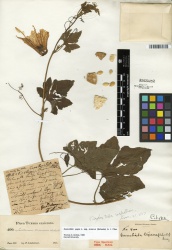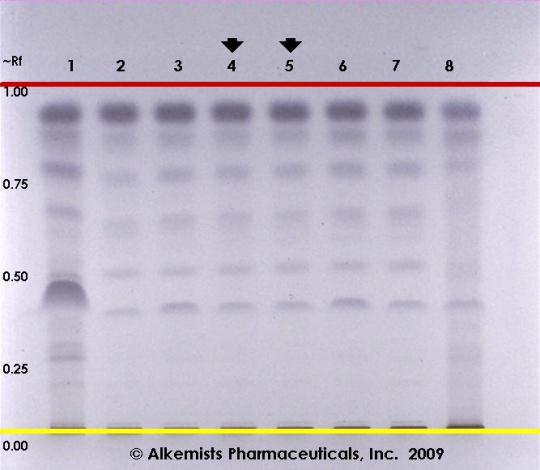Cucurbita pepo (seed)
(add askbox) |
|||
| (9 intermediate revisions by 3 users not shown) | |||
| Line 1: | Line 1: | ||
| − | = | + | {{DISPLAYTITLE:''Cucurbita pepo'' (seed) }} {{askbox|herb=''Cucurbita pepo''}} |
| − | =Macroscopic | + | =Nomenclature= |
| − | =Microscopic | + | {{nomenclature | binomial=Cucurbita pepo |
| − | = | + | |authority=L. |
| + | |family=Cucurbitaceae | ||
| + | |scn=pumpkin | ||
| + | |syn= | ||
| + | |ayurvedic= | ||
| + | |pinyin= | ||
| + | |aka= | ||
| + | |notes= }} | ||
| + | |||
| + | =Botanical Voucher Specimen= | ||
| + | {{Media |cat=Voucher | ||
| + | |||
| + | | source=MOBOT, Tropicos.org | ||
| + | | mainimage=Cucurbita_pepo_subsp._texana_Tropicos_100135770.jpg | ||
| + | | companyimage=TropicosLogo.gif | ||
| + | | companyURL=http://www.tropicos.org/Image/100135770 | ||
| + | | reference=Tropicos.org. Missouri Botanical Garden. 25 Mar 2014 <http://www.tropicos.org/Image/100135770> | ||
| + | |||
| + | | }} | ||
| + | |||
| + | =Organoleptic Characteristics= | ||
| + | {| border=1 | ||
| + | | | ||
| + | {{Organolepsy | source=United States Dispensatory (1918) | ||
| + | | description=[''Cucurbita Pepo'' is] slightly odorous when contused; taste bland | ||
| + | and oily. }} | ||
| + | |} | ||
| + | =Macroscopic Characteristics= | ||
| + | {| border=1 | ||
| + | | | ||
| + | {{Macroscopy | source=United States Dispensatory (1918) | ||
| + | | description=''Cucurbita Pepo'', or common pumpkin, is a plant almost too well known to need description. The seeds are broadly elliptical or ovate, from 15 to 23 mm. in length and from 2 to 3 mm. in thickness; externally yellowish-white, very smooth, occasionally with thin, transparent fragments of adhering pulp and with a shallow groove parallel to and within 1 mm. of the margin; fracture short, seed-coat consisting of a white coriaceous outer layer and a membranous inner layer occasionally of a dark green color; embryo whitish, straight, with a small conical hypocotyl and two plano-convex cotyledons.}} | ||
| + | |} | ||
| + | =Microscopic Characteristics= | ||
| + | {| border=1 | ||
| + | | | ||
| + | {{Macroscopy | source=United States Dispensatory (1918) | ||
| + | | description=Under the microscope, sections of [''Cucurbita Pepo''] show an outer epidermal layer consisting of palisade-like cells, the radial walls attaining a length of 1 mm., the outer walls being usually torn off so that it appears as though the seeds were covered with very long hairs; a sub-epidermal layer consisting- of from 5 to 12 rows of cells with slightly thickened, lignified and porous walls; a layer of strongly lignified stone cells, elliptical in outline and about 0.075 mm. in length; a single layer of small cells resembling those of the sub-epidermal layer; several rows of parenchyma cells with characteristic reticulate markings and separated from each other by large intercellular spaces; several layers of parenchyma cells, the inner layer being more or less collapsed and bounded on the inside by a single epidermal layer, the cells having rather thick walls; the perisperm cells are usually more or less collapsed and the endosperm consists of a single layer of cells filled with small aleurone grains; the cotyledons consist of thin-walled, isodiametric, elongated or palisade-like cells containing a fixed oil and numerous small aleurone grains.}} | ||
| + | |} | ||
| + | =High Performance Thin Layer Chromatographic Identification= | ||
{{HPTLC | source=Elan M. Sudberg, Alkemist Laboratories | {{HPTLC | source=Elan M. Sudberg, Alkemist Laboratories | ||
| description=Pumpkin (seed) (''Cucurbita pepo'') | | description=Pumpkin (seed) (''Cucurbita pepo'') | ||
| Line 28: | Line 67: | ||
| }} | | }} | ||
| − | = | + | =Supplementary Information= |
| − | + | =Sources= | |
| + | <references /> | ||
Latest revision as of 19:29, 2 June 2014
Contents |
Nomenclature
Cucurbita pepo L. Cucurbitaceae
Standardized common name (English): pumpkin
Botanical Voucher Specimen
|
|
Organoleptic Characteristics
|
Macroscopic Characteristics
|
Microscopic Characteristics
|
High Performance Thin Layer Chromatographic Identification
|
Pumpkin (seed) (Cucurbita pepo) Lane Assignments Lanes, from left to right (Track, Volume, Sample):
Reference materials used here have been authenticated by macroscopic, microscopic &/or TLC studies according to the reference source cited below held at Alkemists Laboratories, Costa Mesa, CA. Stationary Phase Silica gel 60, F254, 10 x 10 cm HPTLC plates Mobile Phase chloroform: ethanol [9.5/0.5] Sample Preparation Method 0.3 g + 3 ml CH3OH sonicated + heated @ 50° C ~ 1 hr. Detection Method Vanillin/H2SO4 Reagent -> 110° C 5 min -> visible light Reference see British Herbal Pharmacopoeia, 1996
|
Supplementary Information
Sources
- ↑ MOBOT, Tropicos.org http://www.tropicos.org/Image/100135770
- ↑ United States Dispensatory (1918)
- ↑ United States Dispensatory (1918)
- ↑ United States Dispensatory (1918)
- ↑ Elan M. Sudberg, Alkemist Laboratories http://www.alkemist.com


